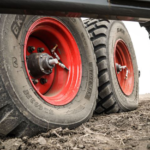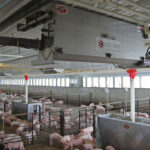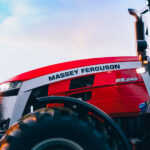Baling Efficiency Redefined
Josh Moorefield, a hay producer from Shreve, Ohio, recently put two balers from different companies to the test in a field consisting of orchardgrass/alfalfa and timothy/alfalfa mixes. He then loaded two semi trailers destined for a customer in Miami, Fla....
Baling Efficiency Redefined
Josh Moorefield, a hay producer from Shreve, Ohio, recently put two balers from different companies to the test in a field consisting of orchardgrass/alfalfa and timothy/alfalfa mixes. He then loaded two semi trailers destined for a customer in Miami, Fla....
Key changes that contribute to increased capacity in the 1840 small rectangular baler are the upturned augers, along with the redesign of the stuffer action to follow the contour of the stuffer floor.
Josh Moorefield, a hay producer from Shreve, Ohio, recently put two balers from different companies to the test in a field consisting of orchardgrass/alfalfa and timothy/alfalfa mixes. He then loaded two semi trailers destined for a customer in Miami, Fla. One truck received bales of both mixes that were bundled by the new Hesston® by Massey Ferguson Model 1840 small rectangular baler that Moorefield had been field testing; the other truck was loaded with bales of both mixes from his competitive-brand baler.
Thanks to the uniform bale size and density of the Hesston bales, Moorefield was able to fit an additional 3,800 pounds on the load. For his customers, that means lower freight cost and more hay.
Building on the success of its predecessor, the Model 1839, Massey Ferguson significantly enhanced the 1840 in terms of high-capacity baling and rugged reliability. The design engineers started up front where pickup and feeder capacity have both been improved—especially in large, uneven and varying crop conditions.
New features also include storage for 10 rolls of twine for fewer stops, an adjustable drawbar that allows attachment to a wider range of tractors and a new, optional knotter fan to keep the knotters clean. The latter is part of a high-performance package that also includes hydraulic bale density for tighter bales. Last, but certainly not least, the 1840 adds 14 more inches to the OptiForm™ bale chamber to ensure greater consistency in bale shape and density.
Higher capacity, faster feeding and denser, more uniform bales, regardless of the crop or crop conditions, are also key features in a new line of Hesston by Massey Ferguson 2900 Series round balers. Available in two models—the MF2946 produces a 4- x 6-foot bale and the MF2956 creates a 5- x 6-foot bale—the new balers feature a redesigned rotor feeder system with adjustable feed auger strippers, as well as more room above the side augers to smoothly pull the crop into the bale chamber. While the new features provide better feeding in all crops, they’re particularly valuable in residue crops such as cornstalks, soybean residue and wheat stubble.
“The new Model 1840 rectangular baler and 2900 Series round balers both feature design enhancements that keep pace with the productivity needs of our customers,” concludes Dean Morrell, product marketing manager for hay and forage equipment. “The Hesston legacy of innovation and commitment to quality is evident in the detailed engineering and rigorous testing that each of these models has undergone.”



